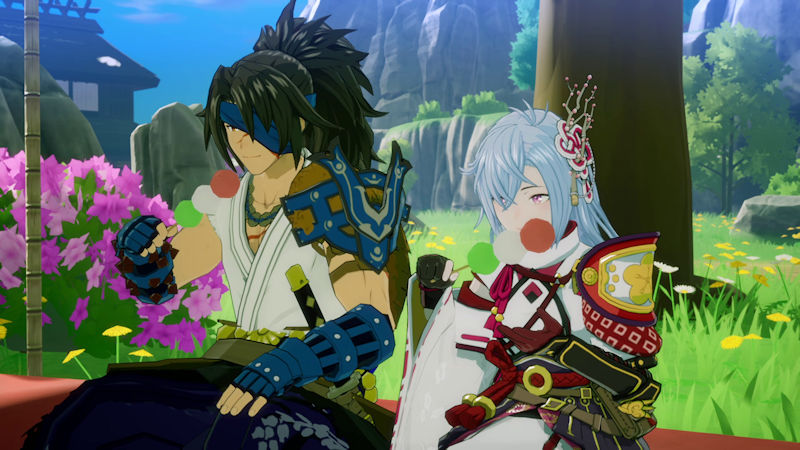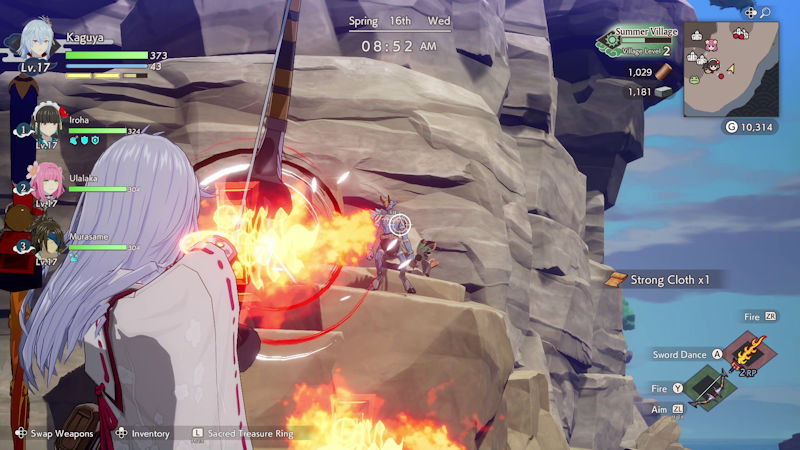
Written by Ross Locksley on 10 Jun 2025
Distributor Marvelous • Price £59.99
There's been quite some excitement about Rune Factory: Guardians of Azuma - certainly the game looked more ambitious than previous entries with some beautiful character designs and the promise of a rich environment to explore and farm. Having spent some time with both the Switch 1 and Switch 2 versions of the game, I can certainly see how that ambition has taken a strain on one and flown on the other, so this is a review of two halves; a game that's good on one console, and great on its successor.
The Rune Factory series has been running for almost two decades, making its debut on Nintendo DS back in 2006, it laid a groundwork that has become very popular with players who enjoy resource management, dating and farming sims.
Fair to say that Rune Factory 5 didn't set the world alight, so developer Marvelous appears to have gone back to the drawing board with a fire lit under their collective backsides. This seems to have worked too, because despite providing us with another amnesiac protagonist, the game has taken a very bold aesthetic route, that of a traditional Japanese village. It looks gorgeous.

The Japanese styling lends the game a lot of character.
Once you've picked one of the two protagonists available (male or female) be prepared for a bit of an education, as the game takes its time tacking you through a bevvy of tutorials and cinematic sequences. You'll learn that you landed in a shrine six months prior, memory lost to you but surrounded by kind strangers that have taken you in. The shrine itself is in disrepair following an event called the Celestial Collapse that hit Azuma fifty years ago, causing the local sacred tree to stop blooming. As your character is an Earth Dancer, you're tasked with restoring life to the tree by bringing back the divinity of the God of Spring.
The game splits the land into four, each representing a season, and all requiring your help to restore the sacred connection to that season's deity. Doing so will unlock a sacred treasure, characters, side quests and areas to rummage around. It's a nicely structured way to open up the game, feeling intuitive as you move along.
One of the major shifts in gameplay is that, while you can still seed and grow resources, you take on a higher management role with the villages, being able to assign villagers to tasks, erect new buildings and add decorations. It's a more empowered and less root-level management style that makes the achievements seem that much more grand and wide-ranging, though you do lose the connection to the seasons as you now effectively have minions to farm and fish for you.

The dev team have clearly upgraded the combat - it's very intuitive and empowering.
This allows the game to put greater emphasis on its strengths, exploration and combat. This leans into Atelier Yumia territory which, despite the base-building mechanic, felt more adventurous than previous entries. So too does Guardians of Azuma which, while not as expansive as one of Link's adventures, offers plenty to discover as you find new ingredients, recipes and save spots. The Sacred Treasures will grant the ability to explore more areas via their skill trees, providing reasons to revisit previous lands.
This is aided by a large and interesting cast of NPC's, 15 of which can be romanced (regardless of gender) which makes the options both varied and open. You'll strengthen your bonds via multiple available options that include dates, meals and gift-giving.

Romancing a character is made pretty easy - increase your bond level to increase your options.
Where this bonding takes off is in hoe it impacts the story, which is more dramatic than most farming sims, tied to cosey gaming as they often are. There's a sense of danger and intensity in Guardians of Azuma which for a player like me is very welcome. I don't mind a bit of recreational and relaxed gaming, but I do like a game to acknowledge that what I'm doing actually matters, even if it's just to NPC's. The game's challenge isn't as demanding as other exploration games, so it should still be enjoyed by those who like a more sedate experience too.
So it's a rich world filled with interesting characters, plenty to see and do with new mechanics to the series that work very well for a first implementation. Let's talk about performance!
So on Switch 1, the game still looks gorgeous, especially with he vibrant OLED screen. However when it comes to combat, it's clear that the hardware struggled - lag comes in to play, the framerate visibly drops (and I'm not someone on the look out for technical stats when gaming, so if I notice it, it's an issue). The picture is a little soft and the assets in game are a little jagged. It is playable, but like Atelier Yumia, it was clearly built with more muscle in mind.
So testing it on Switch 2 was a welcome upgrade - yes, you expect current gen hardware to perform better, but this is reportedly running between 50-60fps over the Switch 1's 30fps, and it absolutely shows. It's smoother, sharper, has no lag and loads faster. It's certainly the ideal way to play on the go, and if you have the new Switch, you can certainly run this with no fear of compromise. Until a new Zelda appears, this is probably the first multi-platform game that I'd prioritise on Switch 2, with a smooth experience coupled with a nice big portable screen making it the perfect time-sink when travelling.
It's a real pleasure to see a game series evolve into a better version of itself, and Rune Factory certainly manages that - a more compelling story coupled with grander management makes the gameplay stand out just as much as the beautiful Japanese aesthetics. If you have a Switch 2, I'd say this is a must-own for the system. Switch 1 owners will have a good time too, but perhaps a tad less enjoyable thanks to the technical limitations.

Ross founded the UK Anime Network waaay back in 1995 and works in and around the anime world in his spare time. You can read his more personal articles on UKA's sister site, The Anime Independent.
posted by Ross Locksley on 06 Jun 2025
posted by Ross Locksley on 30 May 2025
posted by Eoghan O'Connell on 28 May 2025
posted by Ross Locksley on 15 May 2025
posted by Ross Locksley on 09 May 2025
posted by Ross Locksley on 08 May 2025
posted by Ross Locksley on 01 May 2025
posted by Ross Locksley on 25 Apr 2025